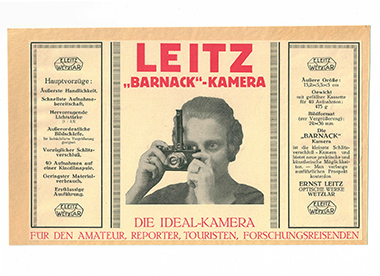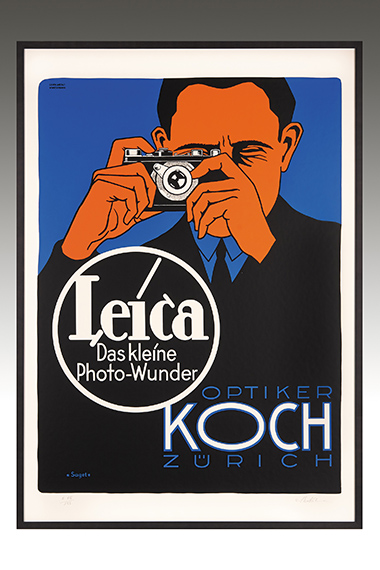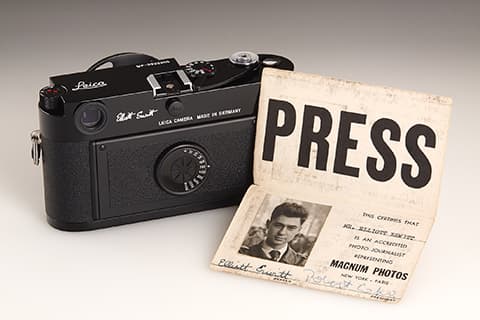Picture (above): Magnum photographer Elliott Erwitt’s first press card, signed by Robert Capa, is expected to fetch thousands at the Westlicht auction on Friday
The official opening of Leitz Park will coincide with Leica marking 100 years since Oskar Barnack developed the Ur-Leica, a prototype model that laid the foundation for the birth of 35mm photography.
The public can get involved in helping Leica mark history, in two ways. On Friday, 100 ‘rare treasures from every epoch of technical development of Leitz history’ will go on sale at a special auction at Westlicht in Vienna, Austria.
The lots include a ‘secret’ Leica camera, specially made to mark the centenary, details of which will be revealed on Thursday.
Leica is also inviting people to visit Leitz Park through a special open day on Saturday. Visitors can look behind the scenes at Leica’s manufacturing processes and witness 100 years of Leica photography through a series of exhibitions.
For details of the 100 Years of Leica auction, and to make a bid, head over to the Westlicht website, or see some of the auction highlights below:
For details of the Open day see HERE
Auction details, supplied by Westlicht:
Special Auction ‘100 YEARS OF LEICA’
WestLicht Auction in Wetzlar, May 23, 2014
Lot 1
Kellner Telescope
c.1852
€30.000/50.000 – 60.000
In 1849 Carl Kellner founded his “Optical Institute” in Wetzlar. In the sales records of Kellner, the earliest case of a telescope with stand is documented on November 25, 1852.
The offered telescope is the earliest known example of a product from the workshop which turned into the Leitz Company in 1869 – a historically significant piece from the earliest time of Cars Kellner’s Optical Institute, and presumably unique.
Lot 5
Broschure ‘Barnack Kamera’
1924
€ 1.600/€ 3.000 – 4.000

The very first brochure for the new camera for 35mm film, extremely rare ! When Oskar Barnack completed the first model of his photo-camera for cine film in March 1914, he called it “Lilliputkamera”, since it was much smaller than the plate cameras customary at that time. The department constructing the camera was called “Barnack Department”; perhaps that is why the first printed matter to introduce the camera simply called it the “Barnack” Camera. Upon realisation that Barnack was not a well-known name, those responsible experimented with contracting the first two syllables of the decisive words: LEICA = Leitz Camera.
Lot 9
Poster
‘Leica Das kleine Photowunder’
c.1928
€ 6.000/€ 12.000 – 14.000
The original Leica vintage advertising poster (size 40 x 50 inches or 101 x 127 cm, framed) by Hubert Saget, signed *Saget*, printed by Graph. Anstalt W. Wasserm
ann, Basel. The possibly unique poster (in perfect condition) was printed for “Optiker Koch Zürich”. Exactly this poster is printed on the back dust cover of Jim Lager, Volume 1, Cameras.

Lot 13
Leica II Mod. D Luxus
1932, No. 98248
€ 120.000/€ 250.000 – 300.000
The discovery of this, up to date, unknown camera is a sensation. It was found many many years ago at the flee market in France and since then it was in a private collection. The owner just recently discovered to have a genuine “Luxus” in untouched original condition. It is not only the very last “Luxus” camera produced, it is also one of only four of which as Leica model D with built-in rangefinder and interchangeable lenses.
In 1929, the price of the original gold-plated Leica “Luxus” with lizard-skin body-cover was twice the price of a regular version. By 1933, Leica production – in total – had already reached more than 100,000 cameras.
On the other hand, less than 100 gold-plated Leica cameras were completed between 1929 and 1933. Today the original “Luxus” Leica is one of the most desirable and rare Leica cameras ever.
Lot 16
E. Leitz New York Leica Gun RIFLE
1937, No. 123
€ 120.000/€ 220.000 – 260.000
The company E. Leitz, Inc. New York launched the Leica Gun Rifle in 1938 using the codeword “Rifle”; however, this was only produced for one year (1938 to 1939). Using the “Rifle”, 1938 saw the first attempts to take photographs with long focal distance just as easily and free-handedly as photographers were accustomed to expect from their Leica cameras. No more than 10 of this spectacular devices are known to exist.
Lot 22
Leica 2500GG w. Leica-Motor MOOEV
1941, No. 352404
€ 120.000/€ 250.000 – 300.00
The Leica 250 was also known as Leica “Reporter”. With its large cassettes it accommodated 33 feet of film, so it could be used for up to 250 exposures without re-loading. Only very few cameras were equipped with an electric motor drive MOOEV and used for aerial reconnaissance by German warplanes, where they were permanently installed. A maximum of 92 motor drives were built, most of which were lost in the air battles.
Lot 52
LEICA M3 Prototype
c.1953, No. 0025
€ 80.000/€ 150.000 – 200.000
Approximately 65 units of the Leica M3 pre-series camera were produced for testing purposes in 1953, and only a very few have survived. There are quite some differences in design still from the first serial production M3s. The camera is in fantastic, almost mint condition. This is a rare opportunity to acquire one of the most important cameras in the history of the Leica M.
Lot 60
MP black paint 1957, No. MP-99
€ 140.000/€ 250.000 – 300.000
The Leica MP is the only serial model which has an individual number, differing fundamentally from the usual fabrication numbers of all other Leica cameras. With a total number of only 412 units produced, the MP is among the rarest Leica models of all times. The black-paint version was produced only 141 times and acquired mainly by professional photographers. Many of the famous Magnum photographers used MP cameras. Today it is among the most sought-after Leicas of all.
At the Cologne “Photokina” fair from September 29 to October 7, 1956, the new Leica MP was first introduced to the public. It was actually a special edition of the M3, but meant to be used with the rapidwinder “Leicavit-MP”. The mere fact that the Leica MP was bought and used almost exclusively by photo journalists allows us to conclude that a second, black-paint MP in this pristine, original state would be practically impossible to find.
Lot 75
Leica M3 black paint “Henri Cartier-Bresson” 1960, No. 993659
€ 20.000/€ 40.000 – 50.000
The camera was used and owned by Henri Cartier-Bresson from end of 1960 until about 1968 when he gave it to Inge Morath. The inside of the back door has a numbering of the serial number by HCB’s handwriting including the initials “HB” by pencil with the same numbering on the base plate.
Magnum photographer Ara Güler took a picture of HCB with this M3 and the Summicron in 1964. In the photo section of the catalog a large print of this image is offered.

Lot 77
Magnum Press Card ‘Elliott Erwitt’
€ 15.000/€ 30.000 – 35.000
This document of history was given to Elliott Erwitt in 1953 as his first Press Card from Magnum. It is signed by its president Robert Capa, the co-founder of Magnum, one year before he stepped on a landmine in the Indochina War. Elliott Erwitt: “In 1953 there was not the membership structure for Magnum. Robert Capa promised to take me in upon my decommission from the U.S. Army. Essentially I became a member of Magnum within hours of my release in March of 1953. 1953 was an easier time with regard to press cards and access to people and events. Still it was good to have something seemingly official as identification. And of course it was a matter of pride to have a ‘press card’ signed by arguably the most important dashing photojournalist from the most prestigious photo agency of the day. Looking at the card now I have difficulty imagining that anyone would take the person pictured (me) seriously looking about 12 years old.” The press card comes with a Leica MP engraved “Elliott Erwitt”.
Lot 100
Leica Edition ‘100 Years of Leica’
2014, No. 001/100
€ 22.000
The anniversary “100 Years of Leica Photography” gives rise not only to numerous events and exhibitions, but also to a very special various anniversary edition. Many of the Leica special editions, elaborately hand-crafted to commemorate special occasions, are rarities featuring special engravings and materials; they are of particular interest to collectors.
As part of the auction, you will have the unique opportunity to purchase one of the most valuable Leica edition. Among the 100 extremely rare “treasures” from the Leitz and Leica world of products, Lot 100 is a current highlight in which the company in Wetzlar celebrates “100 Years of Leica Photography”. The secret will be disclosed on May 22nd, one day before the auction starts.

Photo lots
Lot 102
Oskar Barnack
Conrad and Johanna (the children of Oskar Barnack), Wetzlar 1914
Gelatin silver print, printed c. 1930
€ 2.000 / € 3.500 – 4.000
This photograph from the estate of Oskar Barnack is a very early image taken with the Ur-Leica, i.e. before the introduction of the first Leica serial models to the general market. Barnack developed the Ur-Leica for perforated 35-mm cine film in 1913/14. It allowed for approaching the action more directly and diving deeper into the situation than with any other camera before, which is clearly visible in this picture.
Lot 105
Julius Huisgen (attributed)
Oskar Barnack, Wetzlar 1934
Vintage silver print
€ 2.000 / € 4.000 – 5.000
This vintage print signed by Oskar Barnack comes with his original Leitz carte de visite (“Oskar Barnack Chief designer of the Leica, Wetzlar) from 1928. The print was a gift from Barnack to his daughter that same year.
Lot 109
Alexander Rodchenko
Pioneer with trumpet, 1930
Gelatin silver print, printed 1950s
€ 5.000 / € 8.000 – 10.000
Rodchenko took the famous close-up from a daring bottom view with a Leica in a pioneer camp just outside Moscow. This icon of avant-garde photography goes on auction as an early stamped print from the 1950s.
Lot 116
Dmitri Kessel
Henri Cartier-Bresson with Leica M3, 1955
Vintage silver print
€ 4.000 / € 7.000 – 9.000
This portrait of Henri Cartier-Bresson shows him outfitted with a coat, hat and his Leica (M3 with Summarit 1,5/50mm), pursuing his favourite activity: photography. The picture by Life photographer Dmitri Kessel comes as a rare vintage print.
Lot 125
Inge Morath
Publisher Eveleigh Nash, Buckingham Palace Mall, London 1953
Gelatin silver print, printed in the 1980s
€ 2.000 / € 3.500 – 4.000
This picture of Mrs. Nash and her driver is one of Morath’s most famous images. The photograph was part of one of Morath’s earliest commissions, a photo feature about the inhabitants of London’s Soho and Mayfair for Holiday Magazine.
Lot 132
Ara Güler
Henri Cartier-Bresson with Leica M3, 1964
Gelatin silver print, printed in 2013
€ 6.000 / € 10.000 – 12.000
The “Master of the Leica” with his M3 Chrome. This is the only large format print Güler ever made of this image. This Leica M3, which Cartier-Bresson used to photograph Marilyn Monroe on the film set for The Misfits (1961), among others, is lot 075 in the camera section of the auction.
Lot 145
Elliott Erwitt
The Kitchen Debate (Nikita Khrushchev, Richard Nixon), Moscow July 24th, 1959
3 Vintage silver prints
€ 8.000 / € 15.000 – 18.000
The rare series of three vintage prints includes the key image of the so-called Kitchen Debate, the motif shown on negative no. 58, in which Nixon places his index finger on Khrushchev’s chest, as well as two images taken previously, showing not only the gesticulating opponents, but also the onlookers, including Leonid Brezhnev.
Lot 147
Dennis Stock
James Dean, Fairmount, Indiana February 1955
Vintage silver print
€ 4.000 / € 7.000 – 9.000
The photograph, offered here as a vintage print, was taken in February 1955 when Stock was commissioned by the magazine Life to accompany the 24-year-old film star to New York and to the town of his childhood. Dean had previously completed shooting East of Eden. Stock’s images contributed significantly to Dean’s image as an impetuous yet melancholy rebel.
lot 149
Alfred Eisenstaedt
Marilyn Monroe, Hollywood 1953
Gelatin silver print, printed in the late 1970s
€ 4.000 / € 7.000 – 9.000
This portrait of Marilyn Monroe at the age of 26 was taken by Eisenstaedt in the courtyard of her house in Hollywood for Life. The signed print from the 1970s formed part of Eisenstaedt’s family estate. Eisenstaedt was one of the first photographers who worked exclusively with 35 mm cameras – he bought his first Leica as early as 1931.
lot 158
William Klein
Pachinko Doorman, Tokyo 1961
Vintage silver print
€ 4.000 / € 8.000 – 10.000
The motif of the pachinko doorman, offered as a rare vintage print, was taken in Tokyo and combines all the radical tricks of the trade for which Klein is known. Using the unsparing “in-your-face” style of photography, with the wide-angle lens and blurring parts of the picture by making sudden movements with the camera, Klein takes the momentary character to its extreme
Lot 163
Ulrich Mack
Wild horses, Kenya 1964
Vintage silver print
€ 3.000 / € 5.000 – 6.000
The rare signed vintage print from Ulrich Mack’s legendary photo series comes directly from the photographer’s own holdings. For this reportage, taken on the African steppe in Kenya with a Leica M2, Mack received the renowned World Press Photo Award in no less than four categories.
Lot 165
René Burri
Tae Song Dong, South Korea 1961
Vintage silver print
€ 6.000 / € 10.000 – 12.000
This picture was taken during René Burri’s 1961 trip to South Korea for The New York Times. One evening, René Burri followed American GIs to the village Tae Song Dong, where the soldiers sought distraction with ladies of the night. This apparently casual photograph was to become one of Burris most well-known images and is offered as a vintage press print from the time it was taken.
Lot 166
René Burri
Che Guevara, Cuba 1963
Vintage silver print
€ 8.000 / € 15.000 – 18.000
This extremely early vintage print is one of only 15 copies printed by the photographer himself shortly after the picture was taken. Burri was in Cuba to photograph Ernesto “Che” Guevara, President of the National Bank and Minister of Industry and thus the second most powerful man in Cuba after Fidel Castro, on the occasion of an interview with the American magazine Look.
Lot 167
Alberto Korda
‘Guerrillero Heroico’, Havana, March 5th, 1960
Gelatin silver print, printed late 1960s / early 1970s
€ 6.000 / € 10.000 – 12.000
This icon of the 20th century, taken with a Leica M2, exists mainly in later prints from the 1980s and 1990s. The present print, dedicated by Korda, can therefore be considered an extraordinary rarity due to its early print date (late 1960s / early 1970s).
Lot 172
Thomas Hoepker
Muhammad Ali, Chicago 1966
Vintage silver print
€ 8.000 / € 15.000 – 18.000
This rare vintage print comes from the photographer’s personal holdings and is also the last existing vintage print in his possession. The print was made by Hoepker himself in his darkroom. The legendary photograph was taken with a Leica MP-88, commissioned by the magazine Stern. It became the most well-known image of Muhammad Ali and his portraitist.
Lot 182
Jürgen Schadeberg
‘Nelson Mandela in his Cell on Robben Island (revisit)’, 1994
Gelatin silver print, printed in 2013
€ 2.600 / € 4.000 – 5.000
Schadeberg’s portrait of Nelson Mandela, taken with a Leica M6, is one of the photographic icons of the anti-Apartheid fighter. The sensitive portrait was taken on February 11, 1994, two months before Mandela was elected the first black President of South Africa, when he visited his former prison cell on Robben Island.
Lot 194
Mary Ellen Mark
‘Jesse Damm’ (from ‘Damm Family Revisited’), LLano 1994
Gelatin silver print
€ 2.600 / € 5.000 – 6.000
Mark photographed the Damm family surrounding the drug-addicted parents Linda and Dean twice, first in 1987 and then again in 1994. Both times, she found the family in crisis. The present portrait of Jesse Damm will be auctioned as a signed exhibition print.







